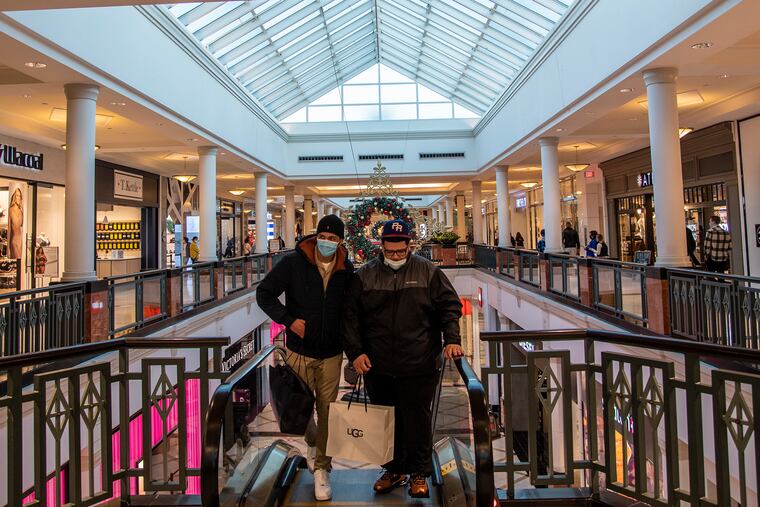The ease of online shopping makes Cyber Monday the year’s busiest shopping day
Online shoppers could spend as much as $12.7 billion on Cyber Monday this year.

U.S. online shoppers were expected to shell out between $10.8 billion to $12.7 billion on Cyber Monday, making it this year’s biggest shopping day, and capping for many a weekend of energetic shopping.
The online-only shopping day is expected to surpass Black Friday, in which customers spent $9 billion this year online. And that was a 22% year-over-year increase from last year, at $7.4 billion.
“This year, more than ever, nobody wants an aggravating shopping experience, whether online or in-store,” said Steven Gartner, executive vice president of global retail services for CBRE. “So, if the shopping trip is at the mall or on the smartphone, the interaction must be friction-free, satisfying, and even enjoyable.”
During the pandemic, droves of customers eschewed crowds in favor of shopping online to curb the spread of the coronavirus. Adobe Analytics, which studied consumer purchases from popular retailers, predicted that Cyber Monday 2020 — the online equivalent of Black Friday — would rank as the year’s biggest day for e-commerce sales, as buyers chased sizable discounts on computers, toys, appliances, and electronics.
“This year will see a dramatic increase in holiday cyber shopping for several distinct, but related reasons,” Gartner said. “Over the past eight months, even the most reluctant online shopper has become more comfortable and adept with web purchases. There is a bit of a switch going on, as they see it as reliable and predictable, while in-store shopping this year is seen by some as the more chancy and unpredictable.”
As Emily Heiss, 27, of Philadelphia, began to shop for holiday gifts this year, she spent extra time searching for custom gifts that couldn’t be replicated by big retailers.
After she found a middle school-era note from her deceased best friend, she included the handwriting to create a ring on Etsy, an online marketplace for handmade and vintage goods, and arranged to send it to her best friend’s sister.
Heiss also shopped on Amazon on Cyber Monday, purchasing an office chair for her husband, who works in sales. She bought more gifts on Amazon and Etsy, too, she said, as well as Anthropologie, and bought locally made candles from a friend.
“I think with everything going on this year, many people are more grateful for the people in their lives,” she said.
So far, Cyber Monday deals that have been announced aren’t much better than Black Friday deals, said Kristin McGrath, editor at BlackFriday.com, which monitors web deals. Harking back to traditional doorbuster Black Friday tactics, many digital shops are likely to offer eye-popping discounts on popular products that usually sell out quickly to attract people to their site, hoping they linger and load up shopping carts with other items.
On average, Adobe said there were 30% discounts on computers, 20% discounts on toys, 21% discounts on appliances, and 26% discounts on electronics. U.S. consumers are projected to spend $189 billion online during the holiday season, the span of time from Nov. 1 to Dec. 31.
Shopping by smartphone has also grown in popularity, Adobe said — markedly so during this year’s Black Friday — and the devices could do as much as 42% of the shopping this holiday season, underscoring the need for retailers to set up sleek, mobile-friendly platforms and ways to pay. Adobe predicted U.S. consumers would spend $28.1 billion on more smartphones this year.
As for in-person shopping at bricks-and-mortar stores, it fell on Friday compared to last year. Tellingly, the giant Mall of America in Bloomington, Minn., reported foot traffic 60% less throughout the weekend than last year, according to the Star Tribune newspaper in Minneapolis.
In online sales, shipping speed, analysts said, will be of critical importance this holiday season amid a flood of online orders and supply chain disruptions at various retailers. Companies are asking customers to buy online and pick up in store, or customers otherwise have to order weeks in advance to receive gifts in time for Christmas.
Dec. 1 is the “golden day” for cheapest shipping, Adobe said, and Dec. 13 is the last day for the cheapest shipping. Sixty-four percent of customers said they would not pay extra for expedited shipping.
The option to buy online and pick up in-store grew more popular. The rate of curbside pickup over the weekend jumped 67% year-over-year, Adobe said. The number of retailers who offered the service grew from 15% to 23%, but that number is expected to grow closer to the holidays as pressure mounts to get merchandise to customers on time.
As small businesses struggle nationally, a greater number of U.S. consumers said they would make a concerted effort to shop closer to home, particularly as larger retailers, such as Walmart and Target have done well during the pandemic.
Without online platforms, or ones that don’t work well, small businesses are at a disadvantage, and are reliant in part upon loyal customers and reputation to carry them through.
“Again, larger brand names win out online, with the deep-pockets and expertise to put forth seamless and glitch-free shopping sites, as well as the ability to continually reengage with the shopper through advanced analytics,” said Gartner, of CBRE. “The large merchants have continued to upgrade and refine their websites, not just their merchandise mix. The local store cannot always provide that same experience as the big merchants.”
Bloomberg News contributed to this article.